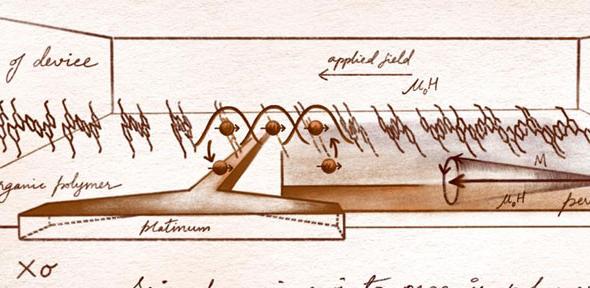
The international team from the UK, Germany and the Czech Republic, have found that these materials could be used for ‘spintronic’ applications, which could make cheap organic semiconductors competitive with silicon for future computing applications. The results are reported in the journal Nature Electronics.
‘Spin’ is the term for the intrinsic angular momentum of electrons, which is referred to as up or down. Using the up/down states of electrons instead of the 0 and 1 in conventional computer logic could transform the way in which computers process information.
Instead of moving packets of charge around, a device built on spintronics would transmit information using the relative spin of a series of electrons, known as a pure spin current. By eliminating the movement of charge, any such device would need less power and be less prone to overheating – removing some of the most significant obstacles to further improving computer efficiency. Spintronics could therefore give us faster, energy-efficient computers, capable of performing more complex operations than at present.
Since organic semiconductors, widely used in applications such as OLEDs, are cheaper and easier to produce than silicon, it had been thought that spintronic devices based on organic semiconductors could power a future computer revolution. But so far, it hasn’t worked out that way.
“To actually transfer information through spin, the electron’s spin needs to travel reasonable distances and live for a long enough time before the information encoded on it is randomised,” said Dr Shu-Jen Wang, a recent PhD graduate of the University of Cambridge’s Cavendish Laboratory, and the paper’s co-first author.
“Organic semiconductors have not been realistic candidates for spintronics so far because it was impossible to move spins around a polymer circuit far enough without losing the original information,” said co-first author Dr Deepak Venkateshvaran, also from the Cavendish Laboratory. “As a result, the field of organic spintronics has been pretty quiet for the past decade.”
The internal structure of organic semiconductors tends to be highly disordered, like a plate of spaghetti. As such, packets of charge don’t move nearly as fast as they do in semiconductors like silicon or gallium arsenide, both of which have a highly ordered crystalline structure. Most experiments on studying spin in organic semiconductors have found that electron spins and their charges move together, and since the charges move more slowly, the spin information doesn’t go far: typically only a few tens of nanometres.
Now, the Cambridge-led team say they have found the conditions that could enable electron spins to travel far enough for a working organic spintronic device.
The researchers artificially increased the number of electrons in the materials and were able to inject a pure spin current into them using a technique called spin pumping. Highly conductive organic semiconductors, the researchers found, are governed by a new mechanism for spin transport that transforms them into excellent conductors of spin.
This mechanism essentially decouples the spin information from the charge, so that the spins are transported quickly over distances of up to a micrometre: far enough for a lab-based spintronic device.
“Organic semiconductors that have both long spin transport lengths and long spin lifetimes are promising candidates for applications in future spin-based, low energy computing, control and communications devices, a field that has been largely dominated by inorganic semiconductors to date,” said Venkateshvaran, who is also a Fellow of Selwyn College.
As a next step, the researchers intend to investigate the role that chemical composition plays in an organic semiconductor’s ability to efficiently transport spin information within prototype devices.
The research was coordinated by Professor Henning Sirringhaus at the Cavendish Laboratory and funded through a European Research Council (ERC) Synergy Grant jointly held by the University of Cambridge, Imperial College London, University of Mainz, Czech Academy of Sciences and Hitachi Cambridge Laboratory.
Reference:
Shu-Jen Wang, Deepak Venkateshvaran et al. ‘Long spin diffusion lengths in doped conjugated polymers due to enhanced exchange coupling.’ Nature Electronics (2019). DOI: 10.1038/s41928-019-0222-5
Researchers have found that certain organic semiconducting materials can transport spin faster than they conduct charge, a phenomenon which could eventually power faster, more energy-efficient computers.

The text in this work is licensed under a Creative Commons Attribution 4.0 International License. Images, including our videos, are Copyright ©University of Cambridge and licensors/contributors as identified. All rights reserved. We make our image and video content available in a number of ways – as here, on our main website under its Terms and conditions, and on a range of channels including social media that permit your use and sharing of our content under their respective Terms.